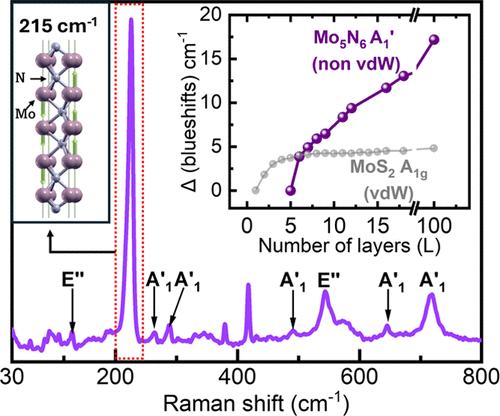二维非范德华 Mo5N6 中的非微观拉曼特性
IF 15.8
1区 材料科学
Q1 CHEMISTRY, MULTIDISCIPLINARY
引用次数: 0
摘要
测量了二维(2D)非范德华(vdW)材料氮化钼(Mo5N6)的共振拉曼光谱,厚度从几纳米到几十纳米不等。实验观察到 15 个不同的拉曼峰,并通过第一原理计算得出了 Mo5N6 最稳定的 AABB 堆积结构。除 215 cm-1 处最强烈的一个拉曼峰外,所有拉曼峰的角度依赖性测量结果都进一步支持了这些赋值。计算显示,215 cm-1 峰不会出现在三维氮化钼中,也不是一阶拉曼活性模式。我们进一步研究了 215 cm-1 峰的起源,并将其归结为缺陷诱发的双共振峰。此外,随厚度变化的拉曼测量结果表明,随着厚度的增加,215 和 540 cm-1 峰(分别归属于面外模式和面内模式)都会发生蓝移,在 20 nm 左右达到一个高点。与其他常见的 vdW 二维材料相比,这种在较宽厚度范围内随厚度变化的拉曼偏移并不罕见,这归因于非 vdW 材料中组成层之间更强的堆叠相互作用。这一发现凸显了拉曼光谱是表征二维非 vdW 材料厚度的重要工具。本文章由计算机程序翻译,如有差异,请以英文原文为准。

Nontrivial Raman Characteristics in 2D Non-Van der Waals Mo5N6
Resonant Raman spectra of a two-dimensional (2D) non-van der Waals (vdW) material, molybdenum nitride (Mo5N6), are measured across varying thicknesses, ranging from a few to tens of nanometers. Fifteen distinct Raman peaks are observed experimentally, and their assignments are made using first-principles calculations for the most stable AABB-stacking structure of Mo5N6. The assignments are further supported by angular-dependent Raman measurements for all peaks, except the most intense one at 215 cm–1. Calculations reveal that the 215 cm–1 peak does not appear for three-dimensional molybdenum nitrides and is not a first-order Raman-active mode. We further investigated the origin of the 215 cm–1 peak and assigned it as a defect-induced double-resonance peak. Moreover, thickness-dependent Raman measurements reveal that both the 215 and 540 cm–1 peaks─assigned to out-of-plane and in-plane modes, respectively─blue shift as thickness increases, reaching a plateau around 20 nm. This thickness-dependent Raman shift over a wide thickness range is nontrivial compared to other common vdW 2D materials and is attributed to the much stronger stacking interaction between the constituent layers in non-vdW materials. This finding highlights Raman spectroscopy as a valuable tool for characterizing the thickness of 2D non-vdW materials.
求助全文
通过发布文献求助,成功后即可免费获取论文全文。
去求助
来源期刊

ACS Nano
工程技术-材料科学:综合
CiteScore
26.00
自引率
4.10%
发文量
1627
审稿时长
1.7 months
期刊介绍:
ACS Nano, published monthly, serves as an international forum for comprehensive articles on nanoscience and nanotechnology research at the intersections of chemistry, biology, materials science, physics, and engineering. The journal fosters communication among scientists in these communities, facilitating collaboration, new research opportunities, and advancements through discoveries. ACS Nano covers synthesis, assembly, characterization, theory, and simulation of nanostructures, nanobiotechnology, nanofabrication, methods and tools for nanoscience and nanotechnology, and self- and directed-assembly. Alongside original research articles, it offers thorough reviews, perspectives on cutting-edge research, and discussions envisioning the future of nanoscience and nanotechnology.
 求助内容:
求助内容: 应助结果提醒方式:
应助结果提醒方式:


